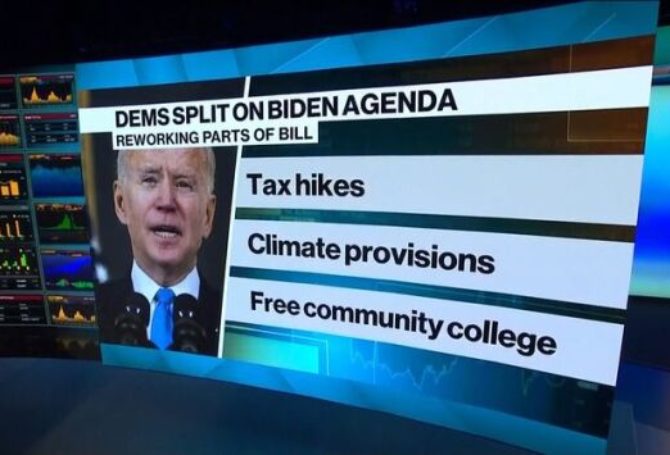
It’s been dubbed the Build Back Better initiative, referred to as the human infrastructure proposal, called the hallmark domestic legislation for congressional Democrats and projected as the legacy for Joe Biden’s presidency. And yet, only 10 percent of Americans admit knowing much about it, according to a recent poll.
What people do know is that whatever the plan contains – or doesn’t contain – has generated tons of debate, partisan bickering and backroom bargaining without, at least to date, any final resolution. President Biden was reduced to trooping off to Europe last week to meet with world leaders while his signature agenda item hung precariously up in the air.
The public’s lack of knowledge has been blamed on press coverage more suitable for a sporting event than a consequential legislative debate. Stories tend to center on trash talking as opposed to substance. That’s not entirely fair criticism. There has been ample coverage of the details (as exemplified by OPB’s coverage) for those willing to read and digest them. But if you only track events on TV, Twitter or a news feed, you probably wouldn’t be exposed to a steady diet of meaningful details or informative updates.
Another excuse for low public awareness is the expansive content in the legislation. That expanse – from childcare to Medicare to climate change – was intended to sweep in a wider array of supporters, fulfilling many campaign pledges. It worked in terms of official support, but it apparently has confused and overwhelmed average American attention spans. When components of the Build Back Better initiative are surveyed separately, most items are popular, but their individual popularity varies from cohort to cohort. It’s like asking people to describe their favorite dish at a smorgasbord.
Superficial coverage has focused on the price tag. Biden’s original Build Back Better initiative totaled $3.5 trillion. Now it’s been whittled down to $1.75 trillion by discarding some elements and trimming funding for others. The legislative scorecard reduces the cost when a program’s funding ends in two or three years. The sums of money and the casual discussion of a billion here and a billion there can be dizzying for voters, especially ones who struggle to balance their own household budget.
Potential tax measures to pay for Build Back Better spending have been hard to follow and often drifts into a class struggle debate over the taxes billionaires should pay. As the overall price tag of the initiative has gone down, seemingly the number of new ideas for raising revenue has risen.
Most people tune out political infighting and have no clue about arcane legislative procedures such as budget reconciliation, the vehicle being used to adopt a version of the Build Back Better initiative because it evades a Senate filibuster by Republicans. Many reports, including our blogs, conflate Build Back Better and budget reconciliation as if they are the same as opposed to a policy proposal and a legislative process. We could do a better job explaining the difference and not adding to the confusion.
The impact of incessant infighting has been to blur what’s in, what’s out, what might stay in, what could come back in the plan. And the infighting isn’t between Democrats and Republicans; it’s just a noisy squabble among Democrats. The Build Back Better initiative gained no traction with Republicans, which is why it wound up in a budget reconciliation package. But Democrats can’t find a way to say “yes” to any configuration of Biden’s proposal. In turn, many voters may have concluded that Democrats talk big, but don’t deliver.
In the process, the bipartisan Senate-passed physical infrastructure bill has languished in the House because progressive Democrats refuse to vote for it until a final deal is reached on the Build Back Better plan.
The core problem Democrats face is there aren’t enough of them, especially in the 50-50 Senate, to move an agenda, especially one that would spend trillions and raise taxes. Congressional Republicans have criticized the overall size of Biden’s plan, but deftly left the nitty-gritty criticism of it to come from congressional Democrats. The result is a portrait of a fractured political party.
Pundits think squabbling Democrats may have already poisoned their chances to remain in nominal control of Congress following the 2022 mid-term elections. No one thinks the internecine warfare on Biden’s agenda is going to help elect a larger Democratic majority – and may endanger inroads Democrats have made with suburban voters and further estrange Latinx voters. The damage is potentially so bad it could impair Biden’s ability to win re-election in 2024 or for another Democrat to succeed him to the White House.
The campaign for governor in Virginia, which produced a narrow win Tuesday for a conservative Republican in a blue-leaning state, is being touted as a blueprint for how GOP candidates can thrive in 2022 at the expense of quarrelsome Democrats. Glenn Youngkin prevailed in Virginia by pounding his conservative agenda while Democrats threw mostly barbs in the absence of a record of major achievements. Youngkin managed to rev up his base while Democrats turned off a significant amount of theirs.
Pundits think squabbling Democrats may have already poisoned their chances to remain in nominal control of Congress following the 2022 mid-term elections.
Biden’s popularity has sunk to a new low and voters appear restless that big promises by Democrats to end childhood poverty, make community college free, create millions of new good-paying jobs, establish paid family leave and enhance benefits for older adults have morphed into what seems like catastrophic failure.
There is a palpable sense that many Americans feel betrayed because Democrats are debating the wisdom of key parts of Biden’s bold social agenda and failing to act. They assumed that’s how Democrats earned back control of Congress. They figure why bother to master the details of a plan that may never come to pass. As Speaker Nancy Pelosi has said, Congress will need to approve the plan before the public takes the time to learn what’s in it.




